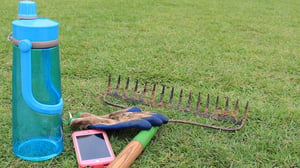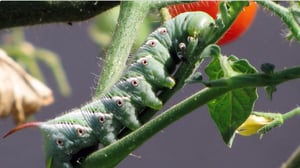Integrated Pest Management (IPM) means determining how to best handle pests for the sake of the environment and your plants. Shannon Hathaway speaks about some natural IPM techniques for keeping pests out of your garden and encouraging healthy plants.
Companion Plants
To ward off pests early on, add some companion plants to your garden wish-list. Companion plants deter pests and attract pollinators. It’s a win-win situation. Here’s a list to get you thinking.
- Marigolds + Tomatoes – Tomato hornworm caterpillars hate marigolds and will scurry the other way if they see these beauties beside your tomato plants
- Rosemary + Roses — Insects and deer will steer clear of your rose bushes if you plant plenty of rosemary. Keep in mind that it takes quite a bit of rosemary to be effective
- Lavender + Extra Garden Space – Deer also hate lavender and other aromatic herbs. Fill in extra space in your garden and add some flavor to your favorite dishes as well.
- Dill + Pollinators – Want to attract some great pollinators for your veggies? Plant some dill to help!
Click here for a list of other companion plants: Urban Farmer Companion Plant Guide
Disease & Insect Prevention
-
Pick up leaves — To prevent fungal diseases, pick up leaves that have fallen on the ground. A wet and warm environment can easily create fungus.
-
Water consistently — Too little water and you’ll have wilting or your tomato plants won't take up enough calcium to prevent blossom end rot. Water too much and the plant will uptake water in excess and this can cause fruit to split. Avoid general problems by watering on a schedule - every-other-day watering in a vegetable patch is usually sufficient.
- Rotate your crops — Wise farmers rotate their crops and allow for rest years by planting cover crops, such as clover. Crop rotation is simply planting a different type of vegetable in a field every 2-3 years. Rotation keeps down insect problems (example: nematodes on tomato plant roots) and ensures soils stay replete with nutrients.
- Incorporate compost — The bacteria and fungus that live in compost are generally the good guys. They colonize the area and often outcompete the pathogens that weaken or kill our crops. We recommend 1 cubic yard of Soil3 is incorporated into 500 square feet of your veggie patch.
Evaluating Your Pest Problem
If your plant does fall victim to pests, do a simple evaluation before determining the need for fungicide or pesticide.
Does the plant have just a couple of holes here and there? Are you willing to give up to 20% of your leaf to the garden critter? If so, you may not need to bother with applying pesticides.
Does your zucchini plant qualify for sainthood because it’s so hole-y? If so, you may want to look into some pest management practices and cut back on the anointed water just a bit.
Okay, okay, enough with the jokes. Here are a couple of links to great websites for evaluating your garden pests and how to treat them.
Stay tuned for more garden tips from the Soil3 organic compost blog.



Did this help you out? Have any questions for clarity? Leave a comment below!